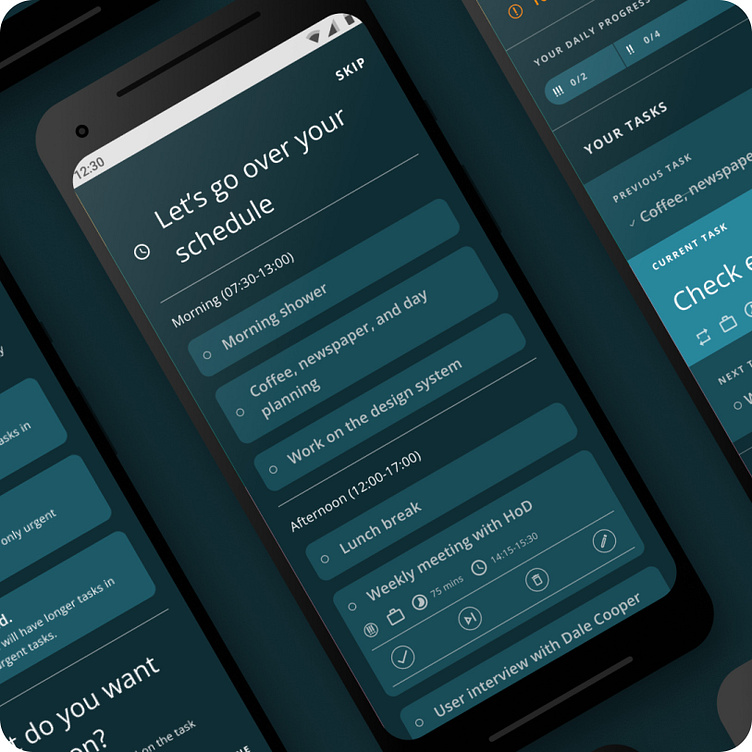Case study: Tomo | Time management made the easiest
Project Information
Scope | Solo, conceptual
Platforms | Android
Timeline | Apr '22 - June '22
Introduction | Project Overview
Information
Currently, I am building a time management tool, Kairos, which is based on some of the premises and business propositions that Tomo confirmed. If interested, please feel free to check Kairos here.
Problem Statement
As remote work gets more and more widespread every day, time management is more important than ever; yet the current time management and productivity tools still face the following problems, resulting in a poorer user experience than users want and deserve:
Proper time management became a task on its own.
When sh*t happens, it is very tedious to re-make your schedule.
Time management tools work for your tasks, not for you.
Solution
A time management product with an automated dynamic scheduling feature that (re-)makes your schedule for you, based on your energy level, and what task categories you want to work on for the day, with only a few clicks, resulting in a significant reduction in time spent on time management.
Research | Tomo kicks off!
Preliminary User Interviews
I have kicked off this project with preliminary user interviews with the following goals:
To understand how people manage their time,
To learn what tools they use, and how they use them,
To learn about the problems they encounter, and
To understand what their ideal time management tool would be like.
During this research phase, I had three very lengthy user interviews and several relatively short interviews.
Key learnings from those preliminary user interviews consist of:
People who consider their lives to be "disordered" prefer to not make any schedules and not use any time management tools, even if they think that they would benefit greatly from them.
Daily energy levels and moods are very important factors for people to consider while making their daily schedules.
It is extremely tedious to bring schedules to date when users do not or cannot regularly update them.
Competitive Analysis
As I had planned to run a solo design sprint of two weeks from zero to the first complete prototype, and I was satisfied with the outcome of my preliminary interviews, I decided to spend the rest of the time allocated for research on extensive competitive analysis.
The purposes of this competitive analysis were:
To understand the common layout patterns they use,
To learn what features users of time management tools look for,
To learn more about people's current problems with their time management, and,
To see what solutions were proposed for those common problems and how the problems I had learned about during the preliminary user interviews were attempted to be solved.
During this extensive competitive analysis study, I have checked almost every single productivity, time management, to-do list, etc. product on ProductHunt and Google Play Store to understand the landscape. Among the crowd, those that deserve at least honorable mentions are Todoist, Reclaim.ai, Untime, Microsoft To-Do, Google Calendar, and Any.do.
Key learnings from the competitive analysis study consist of:
All time management tools ignore the fact that sh*t happens.
Making your daily schedule truly became a task on its own.
Most time management tools create a cognitive overload on their users.
Most time management tools use very similar user interfaces.
Just after I had completed the first iteration of Tomo's prototype, I had a chance to have a discussion with the CEO of quite a successful time management product that is about to launch a new product. Upon taking a look at the prototype I designed, they told me "Because in my experience getting people to use new productivity apps is really hard and having a completely different interface than to what they are used to, makes it harder".
Post-Research Work | So, What Now?
Synthesizing Research Findings
Based on my research, I have concluded that a time management product that I would be designing ought...
to make the user's schedule based on their energy levels and moods,
to be extremely easy to use and reduce the time spent on time management significantly,
to allow the user to (re-)make their schedule based on their input with only a few clicks,
to be there for the user when sh*t happens,
not to clutter the user's mind with information unnecessary at any time, and
to allow the user to focus on "one task at a time".
Automatic Dynamic Scheduling Enters !
While conducting competitive analysis, I came across some products with partially automated schedule making (e.g., Reclaim.ai), but I noticed that they were not making the best use of a feature with a business opportunity with immense value.
After a brainstorming process, I have come up with a task prioritization and sorting algorithm, computationally so simple, that even a beginner like me can code, which I call Automated Dynamic Scheduling.
The algorithm re-queues user tasks based on user inputs (task actions, energy level, task categories) and task properties (due date and time, priority, and appx. time to complete), and further, this can be achieved only with a few clicks, any time the user wants.
In cases where the algorithm has only partial information, the product would prompt the user, asking them to choose between equal options.
So, the user would focus only on the current task which is the highest priority task with the closest deadline and would not be prompted by Tomo unless there is an absolute necessity, e.g., they will miss a deadline for another task if they do not complete their current task shortly.




